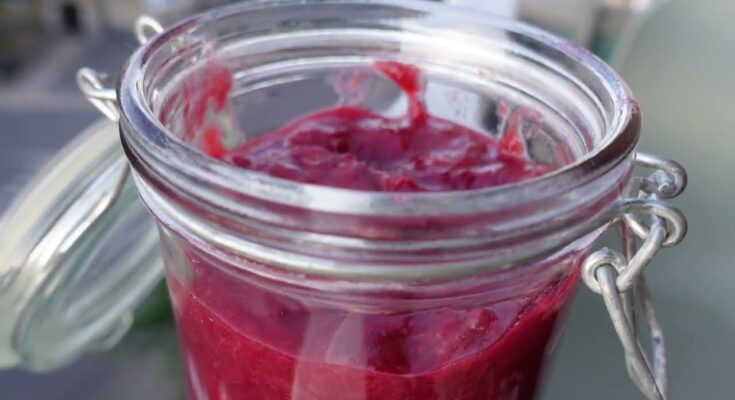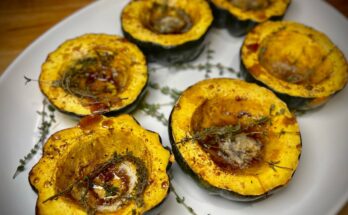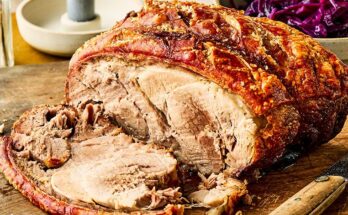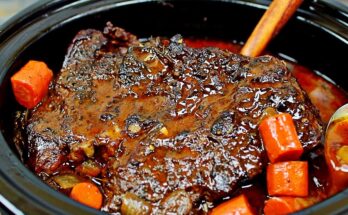Rhubarb Confiture Recipe: Rhubarb confiture, often known as rhubarb jam, is a deliciously tangy and sweet preserve made by slow-cooking fresh rhubarb with sugar and sometimes other flavor-enhancing ingredients like vanilla, lemon zest, or spices. Unlike typical jams, confiture is often smoother in texture and richer in flavor, offering a gourmet twist to the traditional jam concept. This French-inspired recipe transforms the often misunderstood rhubarb into a delightful pantry staple that can elevate everything from toast to tarts.
Rhubarb, technically a vegetable, is celebrated in the culinary world for its bright, tart flavor and its compatibility with sweet ingredients. In a confiture, the sugar softens its sharpness, while slow simmering brings out a jammy texture that clings beautifully to spoons and spreads. It’s not just a way to preserve rhubarb—it’s a way to celebrate it.
This guide will take you through a foolproof, step-by-step method to create your very own homemade rhubarb confiture. Whether you’re a first-time jam maker or a seasoned home cook, you’ll find everything you need here to make your kitchen smell amazing and your tastebuds sing.
Why You’ll Love This Recipe
Let’s be real—store-bought jams are convenient, but they don’t hold a candle to the deep flavor and natural texture of homemade confiture. Here’s why this recipe will be your new favorite:
- Simple Ingredients: No preservatives, no additives—just real food.
- Customizable: Want it sweeter? Add more sugar. Prefer it tangy? Use less. Want to infuse with herbs or spices? Go for it.
- Versatile Use: Breakfast spread, dessert drizzle, yogurt topper—this confiture does it all.
- Cost-Effective: Use fresh, seasonal rhubarb and save money while enjoying something gourmet.
Making rhubarb confiture is also a calming process. There’s something incredibly satisfying about stirring a bubbling pot of fruit and watching it transform into a glossy, thick preserve. Plus, it makes a perfect homemade gift that everyone will rave about.
Ingredients You’ll Need
Fresh Ingredients List
To make a classic batch of rhubarb confiture, you only need a handful of ingredients. Here’s your shopping list:
- 1.5 kg (about 3.3 lbs) fresh rhubarb, trimmed and chopped
- 1 kg (2.2 lbs) granulated sugar
- 1 large lemon, juiced and zested
- 1 vanilla bean or 1 tsp pure vanilla extract (optional but amazing)
These are your base ingredients. Rhubarb is naturally tart, so sugar is not just for sweetness—it also helps preserve the confiture and contributes to its texture. Lemon juice adds brightness and works as a natural preservative, while vanilla adds depth and warmth that balances the sharpness of the rhubarb.
For a deeper flavor, you can also add:
- A small piece of fresh ginger, peeled and grated
- Strawberries (if you want a fruity blend)
- Star anise or cardamom for a subtle spiced note
Quality ingredients are key. Use the freshest rhubarb you can find, and always opt for organic lemons if possible, since you’ll be using the zest.
Optional Add-Ins for Flavor Variation
Want to get a little creative? Rhubarb confiture is incredibly adaptable. Here are some fun variations to try:
- Rhubarb-Strawberry Confiture: Replace 30% of the rhubarb with chopped strawberries.
- Rhubarb-Ginger Confiture: Add 1 tablespoon of freshly grated ginger during the cooking process.
- Rhubarb-Lavender: Add 1 teaspoon of culinary lavender for a floral twist.
- Rhubarb-Orange: Swap lemon juice and zest for orange for a warmer citrus flavor.
- Rhubarb-Chili: Add a pinch of red chili flakes for a sweet and spicy surprise.
Don’t be afraid to experiment—you might just create a flavor combination that becomes your signature!
Choosing the Best Rhubarb
How to Select Fresh Rhubarb
Great confiture starts with great rhubarb. When shopping or harvesting rhubarb, keep an eye out for the following:
- Firm Stalks: Look for stalks that are crisp and snap easily. Limp or soft stalks are a no-go.
- Bright Color: Deep red or pink stalks tend to be sweeter and more flavorful. Green stalks are perfectly fine to use but may be a bit more tart.
- Medium Thickness: Thinner stalks cook faster, but medium-thick stalks hold their texture better in confiture.
Avoid leaves—they are toxic and should be discarded immediately. Only the stalk is edible.
Can You Use Frozen Rhubarb?
Yes! While fresh is ideal, frozen rhubarb works well too—especially when rhubarb is out of season. Just make sure to thaw and drain it thoroughly before cooking, as it tends to release a lot of water. Too much liquid can affect the final texture of your confiture.
One tip: measure frozen rhubarb after thawing, not before, to ensure accuracy. Frozen rhubarb can be slightly more acidic, so you may need to tweak the sugar levels to balance the tartness.
Prepping Your Rhubarb
Washing and Cutting Rhubarb Properly
Preparing rhubarb is simple but important. Follow these steps to get it ready for confiture:
- Trim the Ends: Cut off both ends of the stalk.
- Discard the Leaves: Remember—rhubarb leaves are toxic. Never use them.
- Wash Thoroughly: Dirt can hide in the grooves, so rinse each stalk well under cool water.
- Cut Evenly: Slice the rhubarb into small, uniform pieces—usually around ½ inch thick. Even cutting ensures it cooks at the same rate and gives your confiture a consistent texture.
If your rhubarb is very stringy, you can remove the tough outer skin using a vegetable peeler. This is optional and usually only necessary for thicker stalks.
Tips for Reducing Tartness
Rhubarb’s tartness is part of its charm, but if you prefer a sweeter spread, here are a few tricks:
- Increase Sugar Gradually: Start with the recipe amount and taste midway through cooking. You can always add more, but you can’t take it out.
- Use Sweet Fruits: Strawberries, apples, or even pears can mellow the tartness.
- Balance with Vanilla or Honey: A touch of honey or a splash of vanilla extract can soften the sharpness beautifully.
Now that your rhubarb is prepped, let’s move on to the tools you’ll need to get started.
Equipment You’ll Need
Kitchen Tools Checklist
Having the right tools makes the process smoother and ensures your confiture turns out perfectly. Here’s a basic checklist:
- Large heavy-bottomed saucepan or jam pot
- Wooden spoon or silicone spatula
- Digital thermometer (optional but helpful)
- Sterile glass jars with lids
- Wide-mouth funnel (for easier jar filling)
- Ladle or measuring cup with spout
- Clean towel or paper towels for wiping rims
Using the right tools not only makes cooking easier but also helps you maintain safety and sanitation—especially important when storing confiture for later.
Recommended Jar Types for Storage
For long-term storage, opt for glass canning jars that can be sealed airtight. The most popular sizes are:
- 250 ml (half-pint) jars: Perfect for gifting or sampling.
- 500 ml (pint) jars: Great for regular use at home.
Make sure jars and lids are sterilized before use. You can do this by boiling them in water or running them through a hot dishwasher cycle.
Step-by-Step Guide to Making Rhubarb Confiture
Step 1: Macerating the Rhubarb
Wash and trim the rhubarb stalks, then cut them into small, even pieces. Place the rhubarb in a bowl, sprinkle with sugar, and add a splash of lemon juice. Stir well, cover, and let it rest for several hours or overnight. This step allows the sugar to draw out the rhubarb’s juices, creating a natural syrup that forms the base of your confiture.
Step 2: Cooking the Confiture Slowly
Transfer the macerated rhubarb and its syrup to a heavy-bottomed saucepan. Cook over medium-low heat, stirring occasionally. The mixture will gradually thicken as the rhubarb softens and breaks down. Slow cooking ensures a smooth texture and helps preserve that delicate balance of tart and sweet.
Step 3: Testing for Doneness
After about 25–30 minutes, test the confiture’s consistency by placing a small spoonful on a cold plate. If it thickens slightly and wrinkles when pushed with your finger, it’s ready. If not, continue cooking for a few more minutes.
Step 4: Sterilizing the Jars
While the confiture cooks, sterilize your jars and lids by boiling them in water for 10 minutes. This prevents spoilage and extends shelf life.
Step 5: Filling and Sealing
Once the confiture is ready, carefully ladle it into the hot, sterilized jars, leaving a little space at the top. Wipe the rims clean, seal tightly, and let them cool upside down. Store in a cool, dry place. Once opened, refrigerate and enjoy your homemade rhubarb confiture on toast, pastries, or yogurt — pure, tangy bliss in every spoonful!
Flavor Variations and Twists
Rhubarb confiture is incredibly flexible, and once you’ve mastered the classic version, it’s fun to get creative. Here are some of the best ways to add a unique spin to your next batch:
Rhubarb Strawberry Confiture
The strawberry-rhubarb combo is a match made in flavor heaven. The sweetness of the berries balances the tartness of the rhubarb perfectly.
- Use 1 part strawberries to 2 parts rhubarb
- Add a touch more lemon juice to maintain acidity
- Strawberries add natural pectin, helping with setting
This variation is kid-friendly and great for breakfast or desserts like thumbprint cookies.
Rhubarb Vanilla or Ginger Twist
- Rhubarb Vanilla: Add one vanilla bean, split and scraped, during cooking. The vanilla softens the sharp tang of rhubarb and gives a dessert-like aroma.
- Rhubarb Ginger: Add 1 tablespoon of fresh grated ginger while cooking. This version has a warm, spicy kick that pairs well with cheese boards or as a glaze for meats.
Other ideas:
- Add orange zest and juice for a citrusy lift.
- Use honey instead of sugar (note: this may affect shelf life).
- Blend with raspberries for an intense berry flavor.
With these twists, you can turn one simple recipe into multiple variations that suit any season or craving.
How to Store Your Rhubarb Confiture
Refrigeration vs. Canning
Once you’ve successfully made a batch of rhubarb confiture, it’s time to decide how to store it. Your method of storage will depend on how long you plan to keep it and whether you’ve used a proper canning method.
Refrigeration:
- If you haven’t used the water bath method to can your jars, you’ll need to refrigerate them.
- In the fridge, rhubarb confiture will stay fresh for up to 3 weeks once opened.
- Use clean utensils every time to avoid introducing bacteria.
Canning (Water Bath Method):
- If properly canned and sealed, your jars can be stored in a cool, dark pantry for up to 12 months.
- Once opened, store them in the refrigerator and consume within 3–4 weeks.
- Always check for signs of spoilage—like mold, bubbles, or an off smell—before using.
Freezing:
- You can also freeze rhubarb confiture in freezer-safe containers.
- Leave about ½ inch of headspace to allow for expansion.
- It lasts up to 6 months in the freezer.
No matter the method, always label your jars with the date and contents. It makes organization easy and ensures you use the oldest batches first.
Shelf Life and Best Practices
To maximize freshness and flavor:
- Store jars in a cool, dark place—a pantry or cupboard away from heat and sunlight is ideal.
- Once opened, always refrigerate the jar and consume within a month.
- Do not double dip or use dirty utensils in the jar.
- Inspect the lid before opening. If the seal has broken, discard the confiture immediately.
Following these best practices not only keeps your confiture safe but also preserves the texture and flavor you worked so hard to achieve.
Serving Suggestions
Best Ways to Enjoy Rhubarb Confiture
Rhubarb confiture is as versatile as it is delicious. Whether you’re looking for breakfast inspiration or ways to elevate your desserts, here are some amazing ideas:
- Spread on toast or bagels: Classic, simple, and delicious.
- Swirled into yogurt: Add a burst of color and tang to plain or Greek yogurt.
- Spoon over pancakes or waffles: A fantastic alternative to syrup.
- Fill pastries and thumbprint cookies: Use it as a filling in danishes, croissants, or jam tarts.
- Mix into oatmeal or overnight oats: Adds sweetness and a fruity twist.
- Glaze for meats: Try brushing it onto pork chops or grilled chicken for a sweet-savory contrast.
Looking for something a bit more indulgent?
- Pair with cheeseboards: Rhubarb confiture complements aged cheddar, creamy brie, and blue cheese wonderfully.
- Use as a cheesecake topping: A spoonful over a slice of plain cheesecake turns it into a gourmet dessert.
- Mix into cocktails or mocktails: Stir into sparkling water or gin-based drinks for a tart punch.
The beauty of rhubarb confiture lies in its balance—it’s not too sweet, not too sour. It complements both savory and sweet dishes beautifully.
Breakfast, Dessert, and Beyond
Here are three full-meal ideas using rhubarb confiture:
1. Morning Delight:
- Toasted sourdough
- Creamy ricotta cheese
- Generous dollop of rhubarb confiture
- Sprinkle of crushed pistachios
2. Afternoon Tea:
- Freshly baked scones
- Butter and rhubarb confiture on the side
- Served with black tea or chamomile
3. Fancy Dessert:
- Vanilla panna cotta or ice cream
- Warmed rhubarb confiture drizzle
- Topped with toasted almonds or coconut flakes
Simple to make, yet these ideas bring elegance and flavor to any meal.
Common Mistakes to Avoid
Overcooking or Undercooking
Getting the right consistency can be tricky, especially for beginners. Here’s how to avoid the most common cooking errors:
Overcooking:
- Can cause the sugar to caramelize and alter the flavor.
- Results in a stiff, almost candy-like texture.
- May make the confiture too dark and sticky.
Undercooking:
- Results in a runny, watery spread.
- Doesn’t develop the rich, jammy flavor of a proper confiture.
- Reduces shelf life as the sugar hasn’t fully preserved the fruit.
Tip: Always keep an eye on your confiture during cooking and perform the plate or spoon test mentioned earlier.
Sugar Balance Errors
Sugar is critical in a confiture—not just for flavor but also for preservation. Many home cooks make these common mistakes:
Too Much Sugar:
- Overwhelms the natural tang of rhubarb.
- Leads to crystallization after storing.
Too Little Sugar:
- Results in a sour spread that may not preserve well.
- Makes the texture watery and can cause early spoilage.
If you’re trying to reduce sugar, you’ll need to either consume the confiture faster or store it in the refrigerator or freezer to avoid spoilage. You can also experiment with natural sweeteners like honey or maple syrup, but be aware that the consistency and shelf life may change.
The best approach is to taste as you go and adjust accordingly. Every batch of rhubarb can vary in tartness, so let your palate guide you.
Nutritional Benefits of Rhubarb Confiture
Health Benefits of Rhubarb
While rhubarb is most famous for its tart flavor and culinary uses, it also packs a decent nutritional punch—especially when consumed in moderation as a confiture. Here are some key benefits of including rhubarb in your diet:
- Rich in Fiber: Rhubarb is a good source of dietary fiber, which aids digestion and helps keep your gut healthy.
- High in Vitamin K: One of rhubarb’s standout nutrients is Vitamin K, important for bone health and blood clotting.
- Contains Antioxidants: Rhubarb contains polyphenols like anthocyanins (especially in red varieties), which help fight oxidative stress.
- Low in Calories: On its own, rhubarb is extremely low in calories, making it ideal for low-calorie diets.
It also offers small amounts of calcium, potassium, and vitamin C. Although the addition of sugar during the confiture-making process increases the calorie count, enjoying it in moderation can still be a part of a balanced diet.
Pro tip: if you’re looking to reduce the sugar content without sacrificing sweetness, consider pairing rhubarb with naturally sweet fruits like strawberries or apples. These also add additional nutrients and natural flavor to your confiture.
Calories and Nutritional Breakdown
Here’s a general idea of what you’re consuming per tablespoon (15g) of rhubarb confiture:
| Nutrient | Amount (approx.) |
|---|---|
| Calories | 40–50 kcal |
| Total Sugar | 8–10g |
| Carbohydrates | 10–12g |
| Dietary Fiber | 0.3g |
| Vitamin C | 2–3% DV |
| Vitamin K | 6–8% DV |
DV = Daily Value based on a 2,000 calorie diet.
Although it’s high in sugar, it’s free of fat, cholesterol, and artificial preservatives—especially if made at home. So as long as you’re mindful of portion sizes, rhubarb confiture can be a delightful treat that fits into a healthy lifestyle.
Homemade vs. Store-Bought
Why Homemade Always Wins
Let’s face it—there’s just something magical about homemade. When it comes to rhubarb confiture, making it yourself beats store-bought versions for several reasons:
- Freshness: Homemade confiture is made with freshly picked or carefully selected rhubarb, not commercial-grade puree.
- Control Over Ingredients: No preservatives, artificial flavors, or unnecessary thickeners.
- Custom Flavors: Add what you love—vanilla, ginger, citrus, herbs, or spice.
- Better Texture: You get to decide how chunky or smooth you want it.
- Satisfaction: That feeling of cracking open a jar you made yourself? Priceless.
Plus, let’s not forget the smell of simmering rhubarb filling your kitchen. It’s one of those small joys that store-bought can’t replicate.
Taste, Texture, and Customization
Store-bought versions often sacrifice flavor for shelf life. They might be overly sweet, bland, or have a texture that leans toward gelatinous rather than jammy. Homemade confiture, on the other hand, gives you total creative control.
Want more tartness? Add less sugar. Prefer a thick, chunky spoonful? Skip the immersion blender. Have a favorite spice? Toss it in! You become the artisan, curating a preserve that perfectly suits your tastes and dietary needs.
Homemade also allows you to play with seasonal flavors, turning your confiture into a living recipe that evolves with the year.
Sustainability Tip
Using Every Part of the Rhubarb
Cooking sustainably is as satisfying as it is responsible. While rhubarb leaves are toxic and must be discarded, you can still be resourceful with the rest:
- Peels and Trimmings: Use scraps to make rhubarb-infused syrup or flavored water.
- Canning Waste: Compost fruit pulp left over from other preserves or juices.
- Leftover Confits: Mix smaller batches of various fruit confitures to create unique flavor medleys instead of tossing extras.
Nothing has to go to waste if you get a little creative. Rhubarb is one of those ingredients that keeps on giving—right down to its peels.
Eco-Friendly Packaging Ideas
Homemade preserves also give you the opportunity to reduce your carbon footprint. Instead of using disposable jars or plastic containers, consider:
- Reusing old glass jars (sterilized properly).
- Decorating jars for gifting with recycled paper, twine, or cloth covers.
- Using biodegradable labels or washable pens for marking jars.
These small efforts not only reduce waste but also make your homemade confiture feel extra special—especially when shared with others.
FAQs about Rhubarb Confiture Recipe
Can I reduce the sugar in rhubarb confiture?
Yes, but keep in mind sugar acts as a preservative. If you reduce it, your confiture will need to be refrigerated and consumed within a few weeks. You can also add sweet fruits like strawberries or apples to help naturally balance the tartness.
How long does homemade rhubarb confiture last?
If properly canned and stored in a cool, dark place, it can last up to 12 months. Once opened, it should be refrigerated and used within 3–4 weeks.
Can I freeze rhubarb confiture?
Absolutely! Pour it into freezer-safe containers, leaving room for expansion, and freeze for up to 6 months. Thaw in the fridge before using.
Why is my confiture runny?
It likely wasn’t cooked long enough. Try the spoon or plate test next time to check for doneness. Also, some batches of rhubarb have more water content than others.
Do I need pectin to make rhubarb confiture?
No. Rhubarb contains some natural pectin, and when combined with sugar and lemon juice, it usually sets well. However, if you’re using very watery rhubarb or want a firmer set, a small amount of added pectin is fine.
Conclusion
Making your own rhubarb confiture is more than just a culinary project—it’s a celebration of seasonal produce, self-reliance, and creativity in the kitchen. From selecting the freshest stalks to simmering them into a jewel-toned spread, every step is a labor of love that delivers big on flavor.
Whether you’re spreading it on toast, drizzling it over desserts, or spooning it into your morning yogurt, rhubarb confiture is a versatile treat that adds a tangy-sweet punch to any meal. And the best part? Once you master the basic recipe, the variations are endless.
So go ahead—grab some rhubarb, fire up your stove, and create a jar of joy. You’ll be amazed how such a simple recipe can become a staple in your kitchen and your gift basket.



